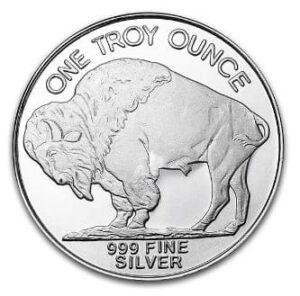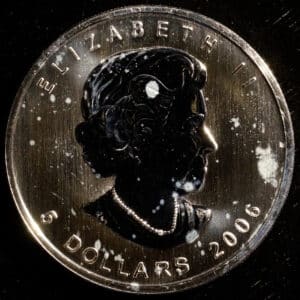Is there a difference? Silver Rounds vs Silver Coins – The 2 best types of Silver to Purchase
Investing in silver has become a popular strategy for many investors, collectors, and hobbyists. Two of the most common forms of silver are silver rounds and silver coins. Despite their similar appearance, there are fundamental differences between the two that can greatly affect the value and appeal of your investment. Understanding these distinctions is crucial for those interested in adding silver to their portfolio. In this article, we will delve into the characteristics of silver rounds and silver coins, focusing on silver Buffalo rounds as an example, to guide you in determining the best type of silver to purchase.
I. Understanding Silver Rounds vs Silver Coins
A. Definition and Characteristics
Silver rounds, as the name suggests, are round pieces of silver that are not considered legal tender. This means that they do not hold a face value that can be used as currency. Instead, the value of silver rounds is derived from their silver content, usually represented as a weight in ounces.
B. Silver Buffalo Rounds
One popular type of silver round is the silver Buffalo round. Inspired by the Buffalo nickel that was minted by the United States from 1913 to 1938, the silver Buffalo round features the same iconic design. The obverse displays a Native American profile, while the reverse showcases an American Buffalo, also known as a bison. Despite their lack of legal tender status, silver Buffalo rounds are sought after by collectors and investors alike due to their historic design and limited mintage.
C. Bullion Rounds vs. Bullion Coins
While both bullion rounds and bullion coins contain a specified amount of silver, they differ in their legal status and source of production. Bullion rounds, like the silver Buffalo round, are not issued as legal tender. Their value lies in their silver content and the appeal of their design. On the other hand, bullion coins are legal tender and are minted by government institutions, giving them an added layer of security and authenticity.
II. Exploring Silver Coins
A. Definition and Varieties
Silver coins are pieces of legal tender that are minted and backed by a sovereign government. These coins carry a face value that is recognized within the country of issuance. Examples of silver coins include the American Silver Eagle from the United States, the Canadian Silver Maple Leaf from Canada, and the Australian Silver Kangaroo from Australia, among others.
B. Sovereign Minted Silver Coins
Sovereign minted silver coins, such as the Silver American Eagle, come with a guarantee of weight and purity from their issuing government. This gives buyers confidence in the coin’s silver content and overall quality. Furthermore, the designs on these coins often reflect the culture, history, or national symbols of the country, adding an element of artistic and cultural value.
C. Fractional Silver Coins
Fractional silver coins are smaller denominations of silver coins, typically weighing less than one ounce. Examples include 1/10 oz, 1/4 oz, and 1/2 oz silver coins. These fractional coins are popular among both investors looking for a lower-cost entry point into the silver market and collectors interested in a variety of designs and denominations.
III. Key Differences Between Silver Rounds and Silver Coins
A. Legal Tender Status
One of the main distinguishing factors between silver rounds and silver coins is their legal tender status. Silver coins, being minted by a sovereign government, carry a face value and can technically be used as currency. Silver rounds, on the other hand, do not have this status and their value is tied solely to their silver content and design appeal.
B. Source of Production
Silver coins are produced by government mints, such as the United States Mint or the Royal Canadian Mint. This gives them an added level of security and authenticity. Silver rounds, however, are produced by private mints. While this means they lack the legal tender status of coins, it also allows for a wider variety of designs and themes.
C. Design and Collectibility
Both silver rounds and silver coins can feature a variety of designs, from historical figures to national symbols to pop culture references. However, the designs on silver coins are generally more consistent and regulated, often reflecting the culture and history of the issuing country. Silver rounds, on the other hand, can feature a wider range of designs, making them appealing to collectors with specific interests.
IV. Factors to Consider When Choosing Between Silver Rounds and Silver Coins
A. Investment Goals
When choosing between silver rounds and silver coins, it’s essential to consider your investment goals. If you’re looking for silver with a face value backed by a government, then silver coins are the ideal choice. If, however, you’re interested in unique designs and lower premiums, then silver rounds may be a better fit.
B. Premiums and Pricing
Pricing is another key factor to consider. Silver coins often come with a premium over the spot price of silver due to their legal tender status and the reputation of government mints. Silver rounds, on the other hand, typically have a lower premium as they are produced by private mints and do not carry a face value.
C. Liquidity and Recognizability
The liquidity and recognizability of the silver you purchase also play a crucial role. Well-known silver coins, like the silver American Eagle or the Maple Leaf coin, are easily recognizable and therefore easier to sell. On the other hand, unique or lesser-known silver rounds may be harder to sell due to their lack of recognition.
Conclusion
The choice between silver rounds and silver coins ultimately depends on your individual investment preferences and goals. Understanding the key differences between the two is essential in making an informed decision. Whether you choose to invest in fractional silver coins, Morgan dollar rounds, Aztec silver rounds, or any other form of silver, remember to research thoroughly, monitor the silver prices, and enjoy the process of building your silver portfolio.












